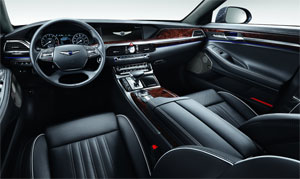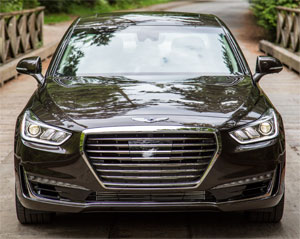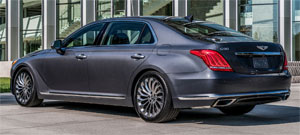2017 Genesis G90
If you thought Hyundai was crazy for trying to cook up a luxury 4-door with the 2009 Genesis sedan…well… for 2017…they’re trying a recipe that seems a whole lot crazier. Hyundai has gone all in and spun off Genesis as a whole new company: Genesis Motors. And their flagship, the G90, is our first taste of the new brand. So, let’s see if it’s well done, or just half-baked…
The Genesis G90 is the successor to the full-size Hyundai Equus, and is built on the lengthened chassis of the mid-size Genesis sedan, now called G80. So, the “90” is, in automotive parlance, an “all-new flagship sedan”. And, a self-proclaimed competitor to large-car stall warts Mercedes-Benz S-Class, BMW 7 Series, and Audi A8. But, we think a more level playing field is with the Lexus LS and Cadillac CT6.
The G90 drives with a super-steady, rock solid feel. A 5 link front and rear suspension combines with electronic adaptive damping to keep things smooth on almost all roads. There was very little harshness, even on some rough pavement in the British Columbian countryside outside Vancouver. The level of isolation achieved is all you could ask for.
 PATRICK LUCAS: "This is a cruiser for sure. On the highway, even on backroads like this, it is just whisper quiet, silky smooth..."
PATRICK LUCAS: "This is a cruiser for sure. On the highway, even on backroads like this, it is just whisper quiet, silky smooth..."
And that lends itself to truly appreciating the interior of the G90. Material quality is top notch. Seat comfort is excellent. And the overall design is clearly one of a top-drawer vehicle.
But the biggest hurdle that Genesis must overcome is separating itself from Hyundai. And seeing some carryover switchgear and buttons will remind more astute observers of the kinship. Get past that, and the G90 is every bit a luxury contender on its own.
Outside, it’s less its own thing, and more a combination of what it aspires to be. The front favors recent Audi A8s, especially the grille. While in the rear, it’s S-Class all the way. Take a step back, though, and it’s a handsome car that demands a second look.
 Under the hood: a brand new standard 3.3-liter twin turbo V6 with 365 horsepower and 376 lb-ft of torque. Power delivery is strong, but perhaps lacks a little maturity in feel. Same goes for the eight speed automatic.
Under the hood: a brand new standard 3.3-liter twin turbo V6 with 365 horsepower and 376 lb-ft of torque. Power delivery is strong, but perhaps lacks a little maturity in feel. Same goes for the eight speed automatic.
PATRICK LUCAS: "The one area it doesn't quite match up to its German competitors, I’d say, is in the powertrain. It's not quite as refined as an Audi, a BMW, a Mercedes-Benz..."
Fuel economy rates 17 city, 24 highway, and 20 combined. That’s about on par with rival V8s. Ditto the energy impact score of 16.5 barrels of oil used, and 7.5 tons of CO2 emitted annually.
A 420 horsepower 5.0-liter V8, and all-wheel drive, are the only options for the G90.
Everything else; automatic emergency braking, blind spot monitoring, adaptive cruise, lane keep assist, head up display, and multi-angle backup camera are standard. That makes for an easy pricing strategy, starting at $69,050. H-TRAC all-wheel drive adds $2,500, while the V8 adds $1,600 more.
 Gaining a foothold is never easy, and in a segment with ultra-high expectations and long heritages, there will be many who look at the G90 as just a dressed up Hyundai. But then, we once said that about Lexus and Toyota too.
Gaining a foothold is never easy, and in a segment with ultra-high expectations and long heritages, there will be many who look at the G90 as just a dressed up Hyundai. But then, we once said that about Lexus and Toyota too.
And, the 2017 G90 is the just beginning for Genesis. And, it is indeed a strong first step towards a time when Genesis Motors and “world class luxury” may be one and the same.
Specifications
- Engine: 3.3 liter V6 / 5.0 liter V8
- Horsepower: 365 / 420
- Torque: 376 lb-ft.
- EPA: 17 mpg city / 24 mpg highway
- Energy Impact: 16.5 barrels of oil/yr
- CO2 Emissions: 7.5 tons/yr
2024 Toyota Land Cruiser
Toyota’s Go Anywhere Globetrotter Returns To U.S.
Every once in a while, we all need a reset. A time to get back to basics and prioritize the things that really matter. Well, for the Toyota Land Cruiser that time is now. So, let’s find out if that means bigger and better things for Toyota’s iconic off-roader.
The Toyota Land Cruiser’s status among the global off-road community is legendary, and it’s hard to imagine there’s any corner of the earth where a Land Cruiser hasn’t kicked up a little dust or mud. Well, 2024 sees the return of the Land Cruiser to the U.S. market after a 3-year hiatus, getting a major reset for the journey.
The reset comes mostly by no longer being based on the large three-row “300-series” chassis, but a new version of the smaller “200-series,” now known as the J250. As with the latest Tacoma, it uses the Tundra pickup’s full-size steel frame.
While the main Land Cruiser model, which goes by simply Land Cruiser, is packed full of luxury and convenience features, there is also a stripped-down model known as the 1958, honoring the first year the Land Cruiser made landfall here in North America. And it is that 1958 we have here, and we were glad to see it, as it also celebrates the original’s back-to-basics approach as a blank canvas for you to personalize as you tackle more and more adventures.
Not that it’s fully stripped down, as 8-inch touchscreen infotainment, a 7-inch full-color multi-information display, and automatic climate control are still standard. Plus, some seriously durable materials, and great heated cloth front seats that throw off some get serious 1990s Tacoma vibes.
But outside, there’s a definite lack of flashy trim and basic looking 18-inch wheels with Yokohama Geolander all-season tires; plus, big chunky bumpers and tilt-up back glass, which is a rarity that we appreciate. Though there is a little too much plastic in places that are sure to see some abuse if you do any significant off-roading.
It even feels a little rough around the edges, but for us it just adds to the rugged old-school utility vibe in a good way.
We did just that, both here in the Mid-Atlantic as well as in the California desert; and while there are some tech-forward driving aids, the actual hardware is in most cases plenty to get things done. That includes standard full-time dual-range four-wheel-drive, locking center and rear diffs, and 8.7-inches of ground clearance. A front stabilizer bar disconnect is also available to allow for increased articulation.
Who needs a V6 or even a V8 when you’ve got Toyota’s i-FORCE MAX setup at your disposal with 326 horsepower and 465 lb-ft of torque coming from a 2.4-liter turbo-four with an electric motor sandwiched between the engine and its eight-speed automatic transmission. Low speed torque delivery is impressive. It even feels a little rough around the edges, which may be a turn off to some, but for us it just adds to the rugged old-school utility vibe in a good way.
And it certainly feels quicker than an off roader needs to be, with an instant torque dump as soon as we eased on the throttle at our Mason Dixon test track; helping us get to 60 in 8.1 seconds and through the quarter-mile in 16.3 seconds at 86 mph. Considering the Land Cruiser’s terrain conquering mission, it behaved quite well in our handling course; it was plenty responsive to inputs, with less body roll than we expected and plenty of grip from the tires. The steering was light and quick but as expected didn’t provide much feel. Other than significant nosedive, braking performance was exceptional. Only 107-feet to panic stop us from 60 mph.
With the shift to the smaller size, there’s no more third row available, and cargo capacity now comes in at 46.2 cubic-feet with a max of a still healthy 82.1. Now, the best part of the Land Cruiser’s return is the entry price of $57,445. That’s about 30-grand less than what the last Land Cruiser went for back in 2021.
Whether it’s over the top fashion trends, mullets, or zombies; just when you think they’re dead, they come roaring back to life. Of course, we’re much happier to see the resurrection of this 2024 Toyota Land Cruiser than any of those things. Toyota is one brand that still recognizes the value of full-framed rugged rigs and has also acknowledged that sometimes less really is more. The Godfather of Toyota off-roading is back and better than ever.







